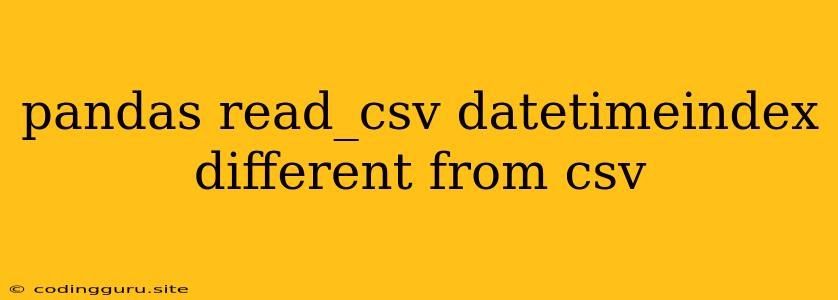Understanding the Discrepancy Between pandas.read_csv DatetimeIndex and CSV Data
Working with time series data in Python often involves reading data from CSV files and then converting it into a Pandas DataFrame with a DatetimeIndex. However, you might encounter a situation where the DatetimeIndex generated by pandas.read_csv doesn't match the datetime information present in your CSV file. This discrepancy can lead to incorrect analysis and insights. This article explores the reasons behind this issue and offers solutions to ensure accurate representation of datetime data in your DataFrame.
Why Does the DatetimeIndex Differ?
The primary reason for this mismatch is that pandas.read_csv doesn't automatically recognize and parse datetime columns in your CSV file. By default, it treats them as regular strings. This means it relies on the parse_dates parameter to guide it in correctly interpreting datetime data.
How to Identify the Problem:
-
Inspect the Data: Examine your DataFrame to see if the datetime columns are being treated as strings instead of datetime objects. You can use
df.dtypesto check the data types of your columns. -
Check CSV Formatting: Analyze your CSV file. Ensure the datetime values are consistently formatted and can be readily parsed.
-
parse_datesParameter: Investigate theparse_datesparameter used in yourread_csvfunction. This parameter dictates which columns should be converted to datetime.
Troubleshooting and Solutions
1. Using the parse_dates Parameter
The parse_dates parameter in pandas.read_csv offers the most direct way to handle datetime data. It takes different arguments, allowing you to specify how and which columns should be parsed.
a) Parsing Specific Columns:
import pandas as pd
df = pd.read_csv('your_data.csv', parse_dates=['Date Column Name'])
This code snippet parses the column named 'Date Column Name' as a datetime object.
b) Parsing Multiple Columns:
df = pd.read_csv('your_data.csv', parse_dates=['Date Column Name', 'Time Column Name'])
Here, both 'Date Column Name' and 'Time Column Name' are parsed as datetime objects.
c) Parsing Combined Date and Time Columns:
df = pd.read_csv('your_data.csv', parse_dates=[['Date Column Name', 'Time Column Name']])
In this case, the specified columns are combined to create a single datetime column.
2. Specifying the Date Format:
If your datetime data follows a specific format, you can explicitly define it using the date_parser parameter.
import pandas as pd
def parse_date(date_string):
return pd.to_datetime(date_string, format='%Y-%m-%d %H:%M:%S')
df = pd.read_csv('your_data.csv', parse_dates=['Date Column Name'], date_parser=parse_date)
Here, the parse_date function converts the date string to datetime based on the specified format.
3. Setting the Index after Reading the Data
If you want to set the index to a datetime column after reading the data, you can use set_index method.
import pandas as pd
df = pd.read_csv('your_data.csv')
df['Date Column Name'] = pd.to_datetime(df['Date Column Name'])
df = df.set_index('Date Column Name')
This approach first reads the data, converts the desired column to datetime, and then sets it as the index.
4. Handling Inconsistent Datetime Formats
If your data contains different datetime formats, you might encounter errors when parsing. In such cases, you can use the infer_datetime_format argument in pandas.to_datetime to allow Pandas to automatically detect the format.
import pandas as pd
df['Date Column Name'] = pd.to_datetime(df['Date Column Name'], infer_datetime_format=True)
Examples:
Scenario: You have a CSV file with a column 'Date' that represents the date in the format 'YYYY-MM-DD'.
Code:
import pandas as pd
df = pd.read_csv('your_data.csv', parse_dates=['Date'])
# Alternatively:
# df = pd.read_csv('your_data.csv', parse_dates=['Date'], date_parser=lambda x: pd.to_datetime(x, format='%Y-%m-%d'))
print(df.dtypes)
Output:
Date datetime64[ns]
Other_Column object
dtype: object
The output shows that the 'Date' column is now correctly recognized as a datetime object.
Conclusion:
Creating a DatetimeIndex from a CSV file using pandas.read_csv requires careful attention to the parse_dates parameter and date formatting. By properly specifying these settings, you can ensure that your datetime data is correctly imported and used for further analysis. Understanding the potential discrepancies and applying the appropriate solutions will lead to more accurate and insightful time series analysis using Pandas.
